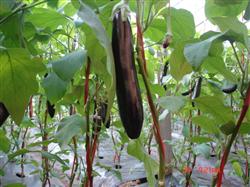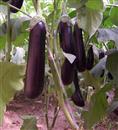Common problems and control of eggplant in greenhouse in early spring

In early spring, various abnormal conditions often occur in eggplant in greenhouse due to low temperature and weak light. the common problems and control are introduced as follows: first, stiff seedlings in early spring often appear rigid seedling symptoms such as small leaves, dark green color, thin stems, less roots and so on. After planting, this kind of seedling is slow, weak and easy to drop flowers and fruits. The cause of the disease is that the temperature of the seedling bed is too low (less than 15 ℃ for a long time). When raising seedlings with heating facilities or nutrition bowls, the disease will occur if the bed soil is too dry if it is not watered in time. Control methods: eggplant seedlings in early spring is in the period of low temperature, so temperature management is the most important. First of all, low temperature tolerant varieties are selected, such as eggplant No. 12 and Yuanza No. 2 in round eggplant, Shouguang purple eggplant in long eggplant, etc.; secondly, heating facilities are adopted, such as laying ground hot lines, covering small arch sheds, second curtains and other thermal insulation facilities to water in time to strengthen the management of temperature and moisture. Second, falling flowers, falling fruits and deciduous flowers do not bear fruit after blooming, lower leaves yellowing and falling in low temperature period, young eggplant softening and falling in high wet period. The cause of the disease: the temperature is too low (less than 15 ℃) or the night temperature is too high (higher than 20 ℃). It is easy to form short stigmas, which generally can not bear normal results. When there is lack of nitrogen fertilizer, the plant growth will become weaker, the branches will be reduced, the flower bud will be poorly developed, the short-column flowers will increase, and the water and fertilizer will be too much, especially when the eggplant is watered, it is easy to drop flowers, fruits and leaves; excessive nitrogen and phosphorus fertilizer will be applied, and the plant will age due to long-term nutritional imbalance, so that the junction of petiole, stem and fruit stalk will fall off due to lack of auxin. Prevention and control methods: strengthen temperature management in the early stage and take corresponding measures to increase temperature. After watering slow seedling water, properly control water squatting seedlings until the door eggplant "stare", end squatting seedlings and begin to water and fertilize. When falling leaves occur, 700 times liquid zinc sulfate solution can be sprayed on the leaves, or zinc nutrients (such as Lvfengbao) can be sprayed on the plants, which can prevent falling and promote growth, and plant growth regulators can also be used to dip flowers and protect fruits during flowering and fruiting period. For example, smear the upper end of calyx and stalk with 20kg 30ml / kg 2Jing 4murd, or spray with 40kg 50mg / kg paracetamol. Third, stiff eggplant shows that the fruit is small, the skin is not glossy, the texture is hard and the taste is poor. The cause of the disease: during the period of fruit expansion, stiff eggplant is easy to occur in the case of low temperature and weak light or high temperature and strong light; excessive amount of phosphorus fertilizer during fertilization affects the absorption of potassium and boron, thus making the fruit ossified; during flowering, it is easy to develop into stiff eggplant due to low temperature and weak light, which leads to poor development of pollen and affects pollination and fertilization. Prevention and control methods: strengthen the management of temperature and light, clean the greenhouse film in time to increase light transmittance, or hang a reflective curtain indoors to increase light; phosphate fertilizer is mainly applied in the roots of seedlings during planting, and less application is avoided in the later stage; attention should be paid to the application of potash fertilizer in the result period, and once there are fruits due to excessive phosphate fertilizer, potash fertilizer and boron fertilizer (potassium sulfate, borax) should be used to reduce harm. Fourth, the double deformity of the double fruit affects the appearance of the goods, but does not affect the quality. The cause of the disease: excessive supply of fertilizer, excessive concentration of growth regulators and deformed eggplant with multi-carpels. Prevention and control methods: strengthen temperature management during flowering, supply appropriate amount of water and fertilizer, and the concentration of growth regulators should be appropriately increased (when the temperature is low) or decreased (when the temperature is high) within the prescribed concentration range. Fifth, split eggplant, non-glossy eggplant fruit split, calyx split, peel dull, poor quality. The cause of the disease: tea yellow mite harm, make the pericarp thickening and roughening, and the internal placenta continues to develop, resulting in the inner growth and outer growth is not long; in the process of fruit expansion, drought hardens the pericarp, and then suddenly watering; in the later stage of fruit development, the soil is dry and short of water. Water supply is not timely. Control methods: use propargite, manganese and other chemicals to control tea yellow mite larvae. There is no shortage of water in the fruiting period, and water should be watered evenly. Sixth, the top leaf wilting plant apical stem bark cork cracking, the leaf color is green, the edge scorched edge yellowing, the fruit top flesh skin is concave, easy to be infected with blight, rotten fruit. The cause of the disease: alkaline soil, or from low temperature and weak light period to high temperature and strong light, the aboveground transpiration increased, but the root absorption capacity was weak, resulting in top leaf withering due to lack of calcium and boron. Prevention and treatment methods: supplement calcium and boron fertilizer on the leaf surface, pay attention to ventilation and cooling in high temperature and bright light days, and spray amiceda, methyl topiramate and other fungal agents when cotton blight occurs. Seventh, the bud is not open, the ovary is not inflated, the bud is tight and not open. Cause: boron deficiency. Control method: foliar spraying 200 times borax aqueous solution or boron-containing micro-fertilizer.
- Prev

How to do well the basic fertilizer work of eggplant
Sclerotinia sclerotiorum is an important disease on eggplant in greenhouse in early spring in coastal areas in recent years, which occurs from seedling stage to adult stage, especially in the early stage of flowering and fruiting, which often causes rot and shedding of buds and young fruits of door eggplant, pair eggplant, main stem and branches, and a sharp decrease in early yield. The symptom of the disease begins at the base of the stem at the seedling stage.
- Next

It is necessary to achieve "three unsuitable" in planting eggplant.
Many vegetable farmers believe that the more the stubble, the more eggplant is harvested, the higher the benefit. But as a result, if there are too many stubbles, the benefit will be reduced. Because eggplant has a certain growth law, only by following this law can we have high benefits. The solution is to use overwintering stubble cultivation, one a year.
Related
- Where is it suitable to grow horseradish in China? it is expected to see the middle altitude horseradish in Alishan.
- How to prevent tomato virus disease reasonably? (Control methods included)
- Many people like to plant towel gourd on the balcony. What are the main points of this method and management?
- What crops can chili peppers be mixed with?
- Fertilization techniques and matters needing attention in Tomato
- What are the grafting techniques for peach seedlings in spring?
- Harm and control methods of root swelling disease of Chinese cabbage
- What are the pests of sweet potatoes? How to prevent and cure it?
- Symptoms, causes and Control methods of navel Rot in Tomato
- The cause of "Cucumber rotten bibcock" in Farmers' planting Cucumber and its Control Plan

